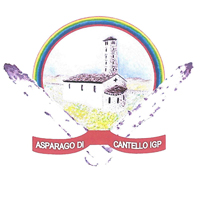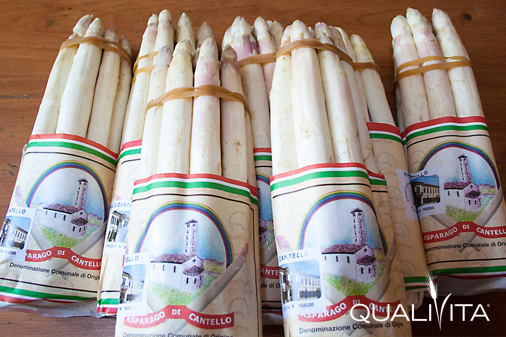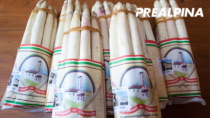Description
Asparago di Cantello PGI is a fresh vegetable belonging to the species Asparagus officinalis L., obtained from the Precoce d’Argenteuil variety and derived hybrids, and the Grolim, Zeno, Cumulus, Vitalim, Giove, Vittorio, Eros, Franco Fruhlim, Magnus, Herkolim, and Terralim varieties.
Production Area
The production area of Asparago di Cantello PGI is within the territory of the Municipality of Cantello, in the Province of Varese, in the Lombardy region.
Production Method
The crops must be grown in open fields. The soil destined for this crop must have a pH ranging from 5.3 to 7.5, and be carefully ploughed to a depth of between 30 and 60 cm before planting. The “legs” (the dormant roots of the asparagus) must be planted in furrows with a depth of 20 to 30 cm, and the distance between the rows must be between 2 and 2.8 metres. In March, ridges of soil are built up along the rows of plants. This is done with a machine that piles up the soil as it passes over the top of the rows. The plants are then covered with a black sheet to protect them from the sun. This cultivation method is used to keep the asparagus white, because natural photosynthesis is blocked when the plants are not exposed to sunlight. The turions (fleshy shoots) are harvested manually between March and June, with the help of a special tool known as a “sgorbia" (Italian for “gouge”). The maximum annual production is equal to 10 tonnes per hectare. Immediately after the harvest, the asparagus are cleaned and packed.
Appearance and Flavour
The turions of Asparago di Cantello PGI are completely white or have a slightly pink tip. They have a maximum height of 22 cm. The texture from the tip to the middle of the asparagus is fleshy, while the bottom half is fibrous. It has a sweet flavour, with a slightly bitter aftertaste and the typical aroma of asparagus, which can range from mild to strong.
History
The first documents mentioning the cultivation of asparagus in Cantello date back to 1831, and are kept in the parish archives. The asparagus that were offered to the church were then auctioned by the parish priest to help with the costs of running the church. Over the years, asparagus became fundamentally important for the town. Cantello’s farmers also sold the asparagus in neighbouring Switzerland. In the early 20th century, Cesare Baj, a prominent man in Cantello, established an annual prize for the best producers, with the aim of encouraging farmers to improve asparagus production. The Cantello Asparagus Festival was established in 1939, and quickly became an extremely popular annual event.
Gastronomy
Asparago di Cantello PGI should be eaten fresh or kept at 4 °C for a maximum of 48 hours. It is rich in vitamins and mineral salts, and thanks to its sweetness it is delicious raw, in salads, paired with fresh cheeses, especially goat’s cheese, or various types of raw or marinated fish. It is mostly served cooked, combined with rice, or fried or poached eggs.
Marketing
The product is marketed as Asparago di Cantello PGI, followed by the specification of the category: Extra, with a turion diameter equal to or larger than 12 mm; First, with a minimum turion diameter of 10 mm; Second, with a minimum turion diameter of 8 mm. The asparagus must be sold whole and fresh-looking, and must be packed in bundles weighing a minimum of 500 g, or in labelled containers which are in compliance with regulations.
Distinctive Features
When very fresh, Asparago di Cantello PGI can also be eaten raw, as it does not have the bitter aftertaste typical of asparagus grown in other areas. It is can be easily distinguished from other asparagus thanks to its unusual whiteness and pink tip.









